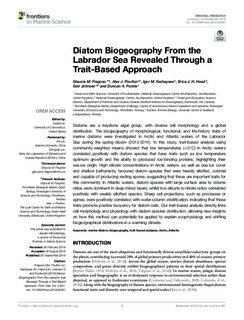| dc.contributor.author | Fragoso, Glaucia Moreira | |
| dc.contributor.author | Poulton, Alex J. | |
| dc.contributor.author | Yashayaev, Igor M. | |
| dc.contributor.author | Head, Erica J.H. | |
| dc.contributor.author | Johnsen, Geir | |
| dc.contributor.author | Purdie, Duncan A. | |
| dc.date.accessioned | 2019-03-06T10:27:19Z | |
| dc.date.available | 2019-03-06T10:27:19Z | |
| dc.date.created | 2018-10-10T16:46:54Z | |
| dc.date.issued | 2018 | |
| dc.identifier.citation | Frontiers in Marine Science. 2018, 5 . | nb_NO |
| dc.identifier.issn | 2296-7745 | |
| dc.identifier.uri | http://hdl.handle.net/11250/2588964 | |
| dc.description.abstract | Diatoms are a keystone algal group, with diverse cell morphology and a global distribution. The biogeography of morphological, functional, and life-history traits of marine diatoms were investigated in Arctic and Atlantic waters of the Labrador Sea during the spring bloom (2013-2014). In this study, trait-based analysis using community-weighted means showed that low temperatures (< 0°C) in Arctic waters correlated positively with diatom species that have traits such as low temperature optimum growth and the ability to produced ice-binding proteins, highlighting their sea ice origin. High silicate concentrations in Arctic waters, as well as sea ice cover and shallow bathymetry, favoured diatom species that were heavily silicified, colonial and capable of producing resting spores, suggesting that these are important traits for this community. In Atlantic waters, diatom species with large surface area to volume ratios were dominant in deep mixed layers, whilst low silicate to nitrate ratios correlated positively with weakly silicified species. Sharp cell projections, such as processes or spines, were positively correlated with water-column stratification, indicating that these traits promote positive buoyancy for diatom cells. Our trait-based analysis directly links cell morphology and physiology with diatom species distribution, allowing new insights on how this method can potentially be applied to explain ecophysiology and shifting biogeographical distributions in a warming climate. | nb_NO |
| dc.language.iso | eng | nb_NO |
| dc.publisher | Frontiers | nb_NO |
| dc.rights | Navngivelse 4.0 Internasjonal | * |
| dc.rights.uri | http://creativecommons.org/licenses/by/4.0/deed.no | * |
| dc.title | Diatom biogeography from the Labrador Sea revealed through a trait-based approach | nb_NO |
| dc.type | Journal article | nb_NO |
| dc.type | Peer reviewed | nb_NO |
| dc.description.version | publishedVersion | nb_NO |
| dc.source.pagenumber | 15 | nb_NO |
| dc.source.volume | 5 | nb_NO |
| dc.source.journal | Frontiers in Marine Science | nb_NO |
| dc.identifier.doi | 10.3389/fmars.2018.00297 | |
| dc.identifier.cristin | 1619456 | |
| dc.relation.project | Norges forskningsråd: 223254 | nb_NO |
| dc.relation.project | Andre: CNPq, 201449/2012-9 | nb_NO |
| dc.relation.project | Andre: NERC NE/H017097/1 | nb_NO |
| dc.description.localcode | Copyright © 2018 Fragoso, Poulton, Yashayaev, Head, Johnsen and Purdie. This is an open-access article distributed under the terms of the Creative Commons Attribution License (CC BY). The use, distribution or reproduction in other forums is permitted, provided the original author(s) and the copyright owner(s) are credited and that the original publication in this journal is cited, in accordance with accepted academic practice. No use, distribution or reproduction is permitted which does not comply with these terms. | nb_NO |
| cristin.unitcode | 194,66,10,0 | |
| cristin.unitname | Institutt for biologi | |
| cristin.ispublished | true | |
| cristin.fulltext | original | |
| cristin.qualitycode | 1 | |

